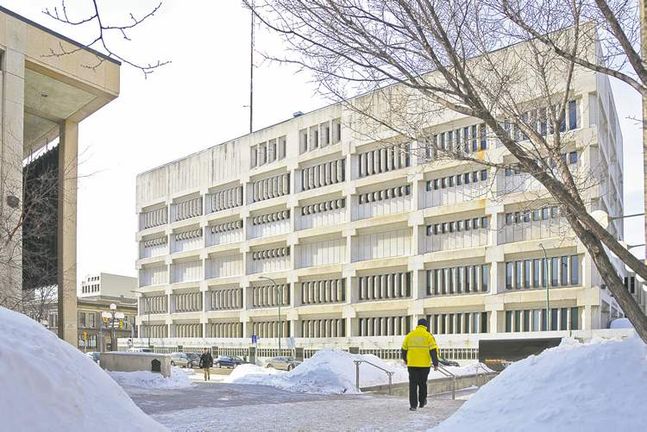
The '60s was a decade of sweeping change and exuberant style; Zeppelin and Floyd, Corvettes and Mustangs, bell bottoms and miniskirts. As the baby-boom generation watched man walk on the moon, the ideas of the past were washed away in a tide of forward-looking enthusiasm.
More than four decades later, we remain enamoured with the psychedelic styles and imagery of the Mad Men era, yet architecture finds itself the one artistic expression from that time that is unloved and even reviled in today's popular culture.
Architecture of the '60s was a celebration of new technologies and a reflection of the ambitious society from which it came. Often criticized for lacking personality and texture, the clean lines of '60s modernism rejected the styles of the past, boldly looking toward the future for inspiration. These ideals extended to urban renewal, which was often seen as a government-led initiative that would sweep away entire neighbourhoods, replacing them with the sterilized order of modernist buildings.
The Civic Centre campus, which included the new city hall, Public Safety Building, Centennial Concert Hall and Manitoba Museum was the manifestation of this movement in Winnipeg. In the name of progress, entire blocks of the downtown were demolished and replaced with a series of monolithic structures that would overwhelm the pedestrian scale and dismantle the neighbourhood's organic composition. This disengagement with the human experience at an urban level contributes significantly to the negative perception of 1960s architecture in contemporary public opinion.
With modern construction technology in its infancy at the time, many buildings of this era have also not aged gracefully. The Public Safety Building, the most brazen of the Civic Centre structures, has for a decade been plagued by significant problems with its Tyndall-stone facade. Steel straps currently hold the panels in place and a protective walkway was built in 2006 to ensure pedestrian safety. With the police soon relocating to the former Canada Post building, the fate of one of Winnipeg's most polarizing structures has become uncertain.
Built in 1965, the PSB is a grand, audacious building designed by Libling Michener & Associates in the brutalist style of modernism. Brutalism is precisely as it sounds. It is characterized by heavy, fortress-like massing, aggressive lines and cold materials. It was a style as unapologetic as the skimpy bikinis and wide-collar shirts that defined the brash 1960s. Brutalism is not endearing. It is uncomfortable and challenging. It is a style you either love passionately or you absolutely despise. There is no indifference.
Because of the visceral reaction these buildings elicit, they are commonly disliked and are more often demolished than redeveloped.
Preservationists argue buildings such as the PSB represent a time in our history that is important to recognize and protect. They maintain that while the ideals of brutalism may not be in line with current architectural sensitivity, its evocative expression can provide visual texture and animation to a vibrant city. Acknowledging brutalist buildings can be difficult to live with, its supporters stress they are rarely bland and always evoke an emotional response that can enrich the experience of urban living.
Brutalist structures portray an image of bravado, making them popular across North America for government and law-enforcement buildings. In a parallel saga, the PSB's smaller, less flamboyant brother across the river also faced an uncertain future. Designed in a softer version of brutalism in 1963 by renowned local architect Étienne Gaboury, the St. Boniface Police Station on Provencher Boulevard was declared surplus by the city following construction of a new facility in 2008.
Similar to the PSB, the structural rigidity and harsh aesthetics typical of brutalist buildings led to the complex remaining vacant and being threatened with demolition. Recently, two proud members of the local community stepped forward with a plan to convert the facility into a francophone medical clinic. Having been saved from the wrecking ball, the building's impending redevelopment provides hope others of its kind might also find new life.
The Public Safety Building's introverted plan and segregation from the street makes it a much more difficult building to redefine and reconnect to its surroundings. Its scale, technical challenges and cost of redevelopment likely mean it will not meet with similar fortune.
Whatever its future holds, the opportunity exists with the PSB to inspire public debate about the definition of heritage in our city's built environment. Should it be limited to buildings with cornices and arched windows or might heritage be defined more broadly to include all the significant architectural styles that work together to create Winnipeg's multi-layered narrative, rich urban character and visual texture?
In a city that allows its old airport terminal to be so easily demolished and offers such little resistance to the loss of century-old buildings in its National Historic Site, it would certainly be an uphill battle to arouse public support for the inclusion of modernist and even unfriendly brutalist buildings under the preservationist umbrella.
As we finally begin to shed our image as a city of uninspired architecture, however, it might serve us well to find a place in our urban renaissance for provocative older buildings such as the PSB. Like renovating the bathroom in your suburban '60s bungalow and leaving the original pastel green toilet and tub, some will hate it, some will love it, but it is guaranteed to enliven the conversation and inspire reaction.
Brent Bellamy is senior design architect for Number Ten Architectural Group.
bbellamy@numberten.com
Republished from the Winnipeg Free Press print edition February 25, 2013 B4

